The Empress’s New Clothes: Leftist Self-Worship and the Cult of Artemisia Gentileschi
“She was a genius,” says the Guardian. She was a “uniquely gifted artist who should be considered among the all-time greatest painters,” says the BBC. I say, no, she was not. The Italian Baroque painter Artemisia Gentileschi (1593–c.1656) was not a genius, was not uniquely gifted and should definitely not be considered a great painter. But don’t take my word for it — see for yourself. Here is one of her most famous and extravagantly praised paintings:
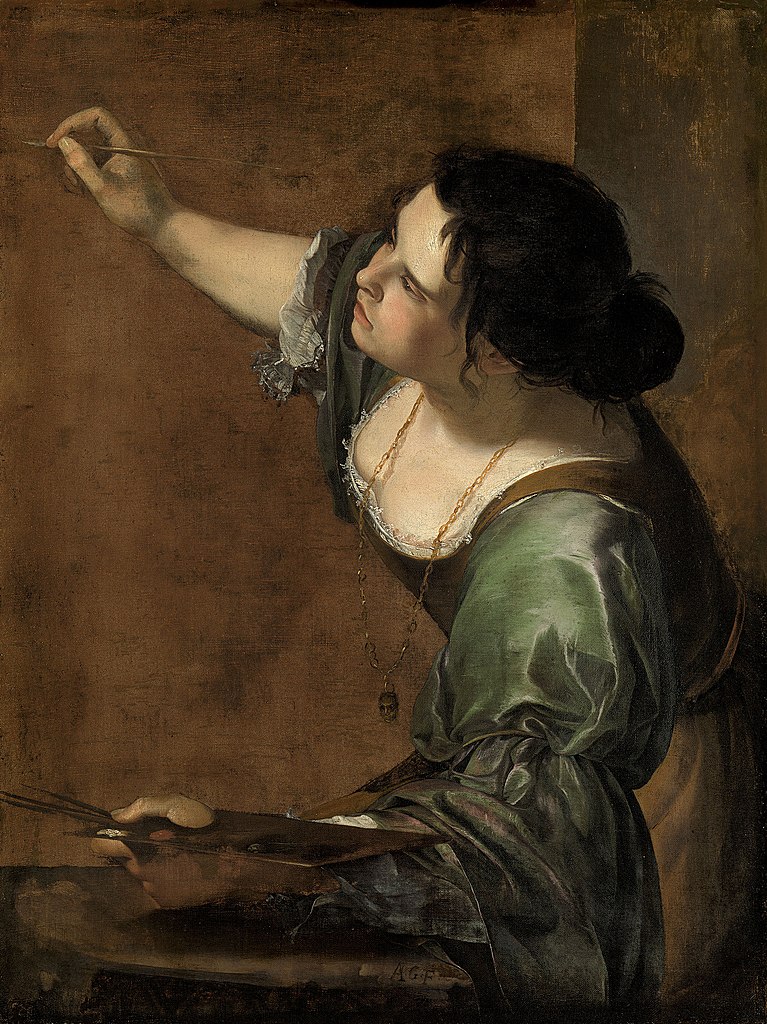
Self-Portrait as the Allegory of Painting (c. 1640), Artemisia Gentileschi
Given the title of Gentileschi’s self-portrait, you can’t fault her ambition and egocentricity. But you can fault her perspective, her composition, her colouring, her grasp of her own anatomy, and her ability to represent fabric, flesh, and hair. Here for comparison is a self-portrait by a genuinely gifted female artist, the French Élisabeth Vigée-Le Brun (1755–1842):
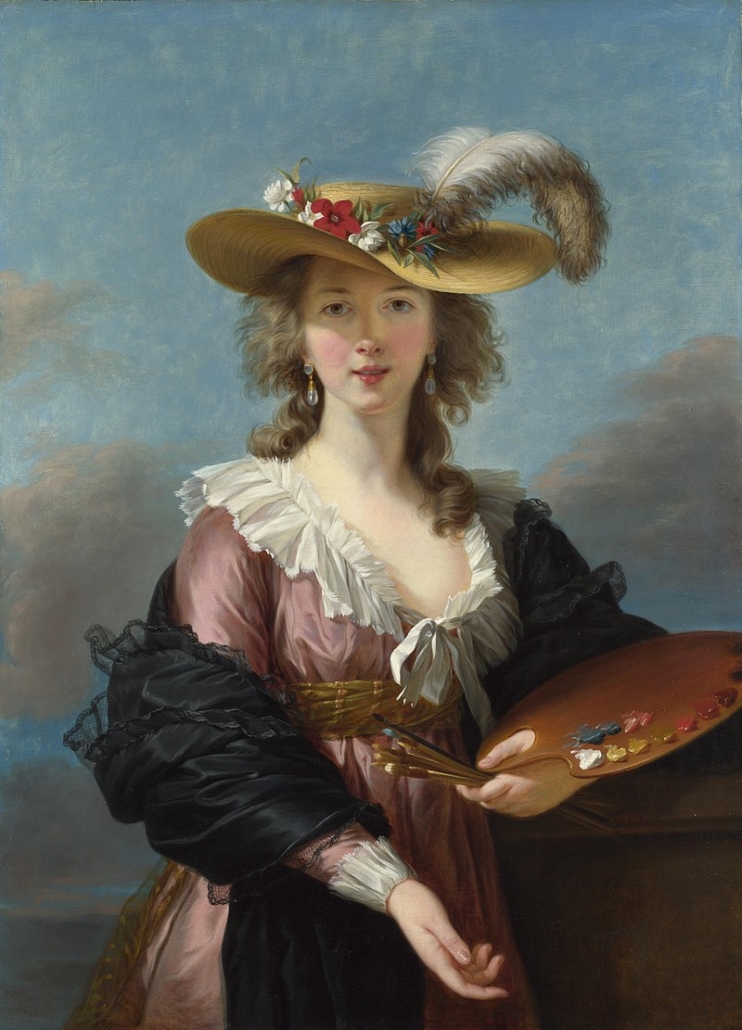
Self-Portrait in a Straw Hat (1782), Élisabeth Vigée-Le Brun
Vigée-Le Brun represents herself as attractive and enjoying both life and being a woman. Feminists don’t want women to be attractive and happy like that. They want women to be unhappy, angry and militant. That’s one big reason they prefer the untalented Gentileschi to the highly talented Vigée-Le Brun. I don’t think Gentileschi’s Self-Portrait as the Allegory of Painting even rises to the level of bad art. The words that come most naturally to my lips are “bloody awful.” The first time I saw the painting in a book of art history, I wondered whether its inclusion was a joke or mistake. How could any art-historian or critic take that mess seriously?
The siren-song of solipsism
Very easily, it became apparent. And very prudently too. Anyone at the Guardian, BBC or other leftist institution who spoke the truth about Artemisia Gentileschi’s sometimes execrable art would be in serious trouble. If Gentileschi had been a man and painted to the same low standard, she would quite rightly have been forgotten long ago. But she was a woman and a “rape-survivor,” so feminists in the 1970s decided to create a cult around her. By worshipping her, they were really worshipping themselves, because I think some or perhaps most feminists don’t see other women as individuals or even as human beings in their own right. Instead, those feminists see other women as reflections of themselves or as counters in the feminist struggle for power and self-assertion.
But this inability to see others as real applies more generally to leftists and their supposed objects of concern. I was struck by this passage in The Liar (1991), an autobiographical novel by the near-ubiquitous British leftist Stephen Fry: “For Adrian other people did not exist except as bit-players in the film of his life. No-one but he had noted the splendour and agony of existence, no one else was truly or fully alive.” Fry is homosexual and half-Jewish, which may also be significant, but his solipsism is, I’d argue, an important feature of leftism. For leftists, collectivism is really the simplest and surest way to exalt the self. And you can see these aspects of leftism in the cult of Artemisia Gentileschi — and also in Gentileschi herself. Her bad art is now being worshipped in a major exhibition at the National Gallery in London. Here’s how Rhiannon Lucy Cosslett of the Guardian reacted when she overheard some truth-telling at the exhibition:
Artemisia’s features, in the guise of myriad saints and figures from myth and religion, are everywhere. As Laura Cumming wrote, she “seems to live inside every role she depicts”. I delighted in this, but other visitors did not. “Self-obsessed”, said one older man, and I laughed to myself because, really, his remark was just too perfect, too predictable, too tediously sexist for words. The history of women and art has been, in the main part, a history of bodies. Bodies stripped of clothing and imagined and objectified by men. Yet running alongside this parade of breasts and bottoms as conceived by the male gaze is a subversive counterhistory: that of women artists seeing themselves. (The history of art is full of female masters. It’s time they were taken seriously, The Guardian, Rhiannon Lucy Cosslett)
Yes, Gentileschi did see herself. She then put herself down on canvas, over and over again, in awkward, ugly, ill-coloured ways. That is subversive, I suppose. It’s definitely self-obsessed. Rhiannon Lucy Cosslett says the remark by the “older man” is “tediously sexist” because she can’t say that it’s untrue. Gentileschi also sometimes looks self-pitying, as in her Self-Portrait as Martyr, the painting on the left below:
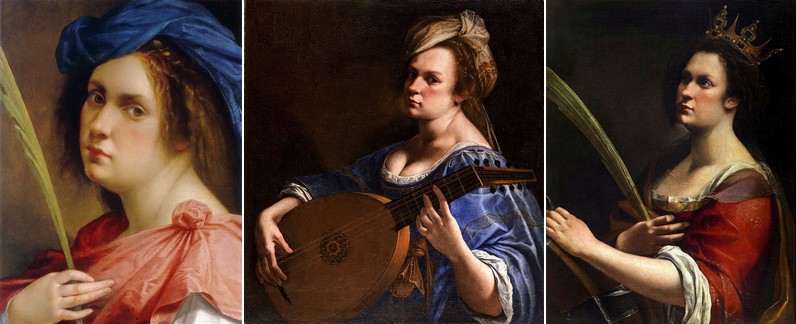
Some of Artemisia’s subversive self-obsession: self-portraits as martyr, lute-player and St Catherine
Cosslett both explains and echoes the self-pity: “Artemisia was a survivor of male violence, just as I am. Tears sprang to my eyes when I looked at the transcript of her torture during her rapist’s trial, and read that she had repeated ‘è vero, è vero, è vero’ (‘it is true, it is true, it is true’).” I’d suggest that Cosslett wept for herself, not for Gentileschi. That is, Cosslett sees Gentileschi as a reflection of herself, not as an individual. That’s why objective standards of good and bad art don’t apply in the cult of Artemisia Gentileschi. She and her art serve to reflect feminists back at themselves.
And her art is probably even more appealing to feminists because, unlike Élisabeth Vigée-Le Brun’s, it is bad art. Leftists hate beauty, truth and goodness, and delight in the destruction of those things. The cult of Artemisia exalts ugliness and insists on untruths: Artemisia was a “genius,” a “uniquely gifted artist … among the all-time greatest painters.”
Chopping off White men’s heads
The cult also celebrates the overthrow of White men, because this is Gentileschi’s most famous painting in its two versions:
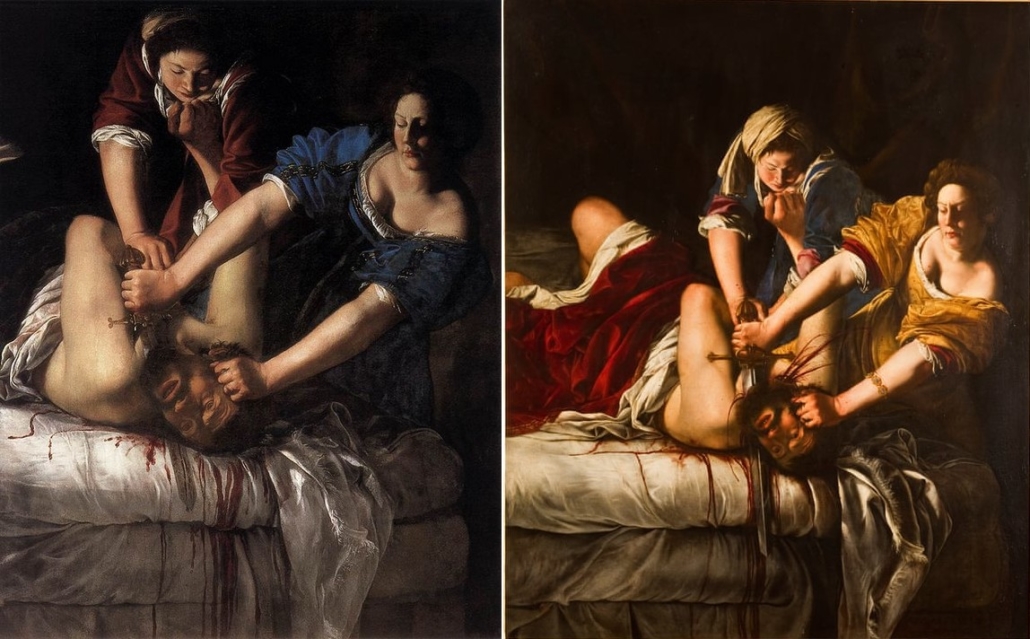
Judith Beheading Holofernes
Many painters have represented the ethnocentric Old Testament story of a Jewish heroine killing a gentile to defend her people, but few have done it as badly as Gentileschi did. And here is another of her bad paintings on a similar theme:
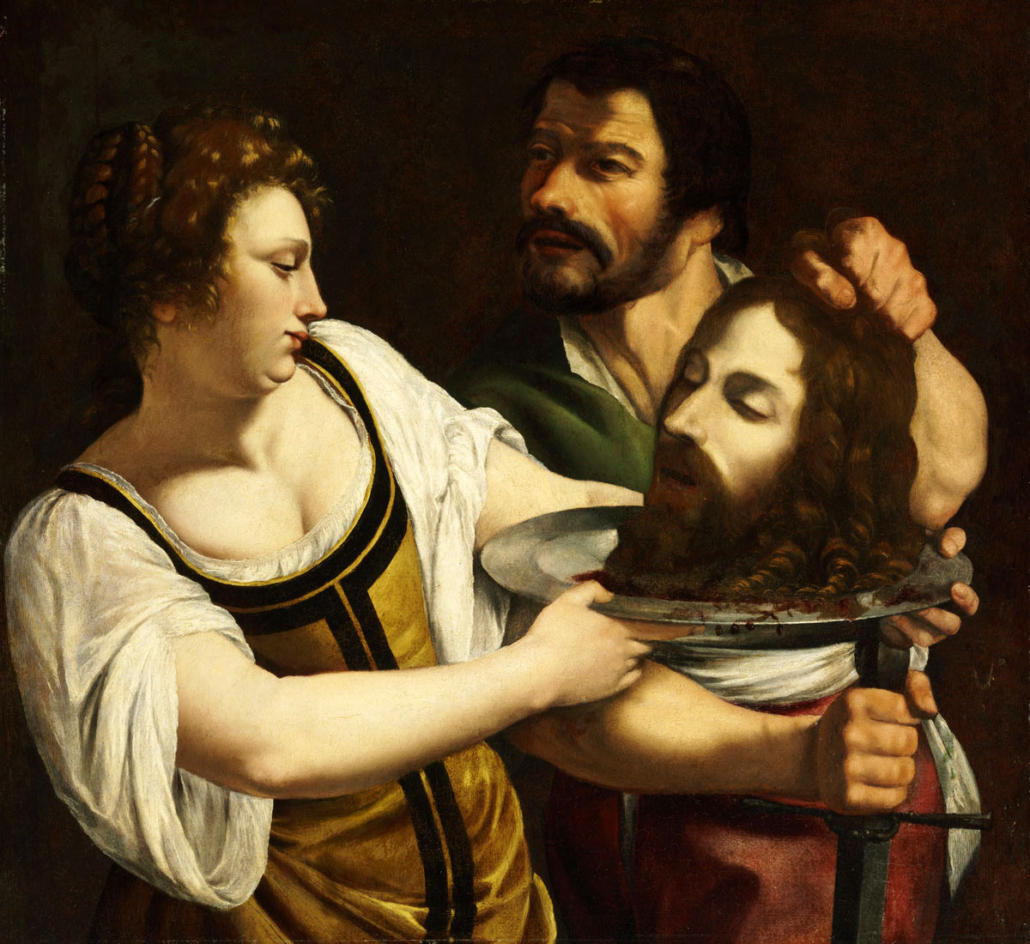
Salome with the Head of Saint John the Baptist (c. 1615)
Gentileschi places herself on canvas, dealing death to White men, and feminists can again see themselves reflected in her bad art. If you want to see how a real genius represents Judith’s death-dealing, here is Caravaggio:
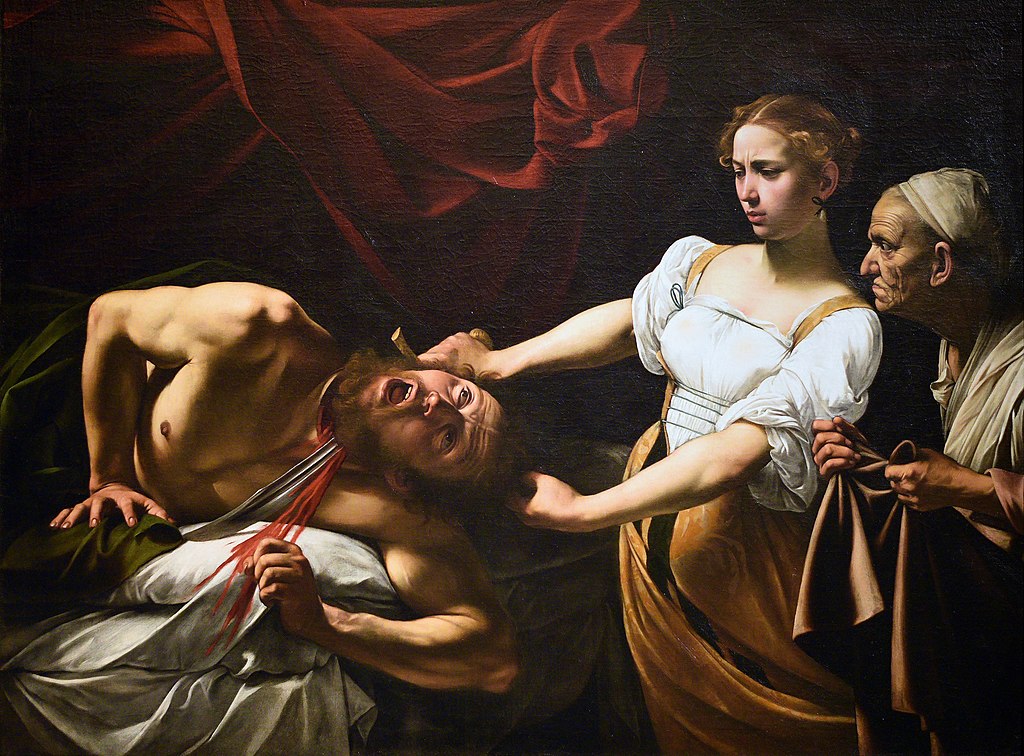
Caravaggio’s Judith beheading Holofernes (1599)
Compositionally, that isn’t one of Caravaggio’s best paintings: it isn’t a realistic portrayal of what such a beheading would have looked like (according to the apocryphal Book of Judith, Holofernes was drunk and helpless when Judith cut off his head as her maidservant kept watch at the door of his tent, but painters have understandably chosen more drama and less drunkenness). Gentileschi understood Judith’s task better, which is why she shows the beheading as a collaboration. After all, men are on average far more physically powerful than women, as Gentileschi presumably learned when she was raped by her father’s assistant, Agostino Tassi.
Victimhood valorizes
So yes, she was the victim of a bad crime and yes, the crime was compounded by the torture she endured to prove her accusation against Tassi. But her victimhood does not “valorize” her art (to use an ugly neologism found in this feminist art-criticism on Gentileschi). Her art is still bad and Caravaggio’s is still sublime. I’m not disturbed by Gentileschi’s decapitations. They might be more realistic, but they don’t look real. Caravaggio’s decapitation does look real.
And while Gentileschi painted herself as a martyr and saint, as you can see above, Caravaggio painted himself as a sinner, as you can see below:
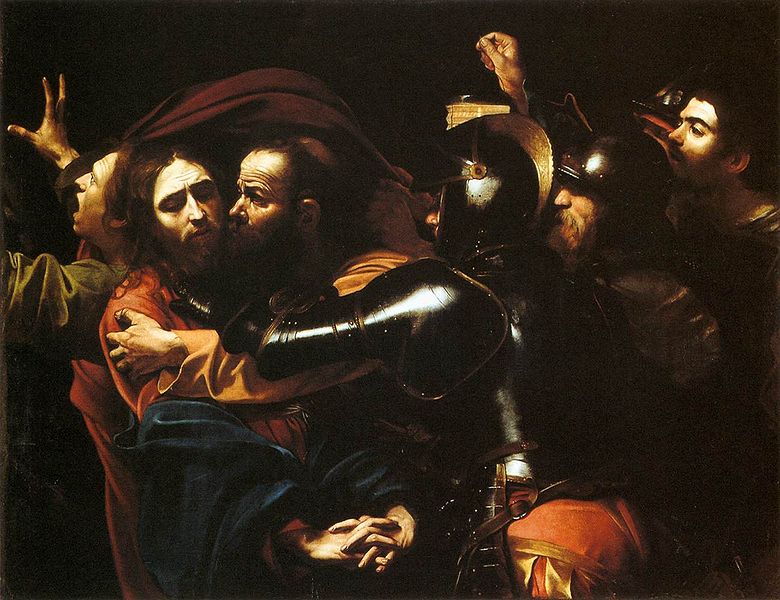
Caravaggio’s The Taking of Christ (c. 1602)
The figure on the far right, holding up a lantern to assist the taking of Christ for trial and crucifixion, is probably Caravaggio himself. That is a very simple and effective way to represent a difficult but essential Christian doctrine: that we all bear responsibility for the crucifixion of God’s only-begotten son.
Anatomy out of whack
It’s also significant, I think, that Caravaggio has given a determinedly gentile face to the kiss-bestowing Judas, an archetypal Jewish villain in so much Christian iconography. There’s no evasion of responsibility here: Caravaggio is saying “I did it; you did it; we all did it.” But if Artemisia Gentileschi had attempted the same scene, I think her first impulse would have been to give Christ her own features and thereby play the victim again. She certainly couldn’t have painted to Caravaggio’s sublime standards. He could represent reality; she couldn’t. Even the Guardian and BBC acknowledge Gentileschi’s artistic failings:
Her anatomy is sometimes out of whack, her details occasionally glossed over (or perhaps painted by assistants). … the single light source in [Judith and her Maidservant with the Head of Holofernes (1623-5)] — a candle near Judith’s upper arm — is in the wrong place. It is too far behind Judith, who has her left hand held out catching the light that is clearly behind it, which is not possible. The mistake is compounded by a poorly painted shadow covering much of Judith’s face, which is also not possible. It’s a splodge and a botch. (Artemisia review — overwhelmingly present, The Guardian, 4th October 2020; Artemisia Gentileschi: Will Gompertz reviews her show at the National Gallery, BBC, 3rd October 2020)
Will Gompertz of the BBC then says: “And yet. Who cares?” I care and so should everyone who wants to defend artistic standards. Gentileschi’s failings aren’t minor and incidental, but major and characteristic. It matters that her “anatomy is sometimes out of whack” and that Caravaggio’s isn’t. She aimed for realism like him and didn’t achieve it. And without the example and inspiration of male painters like Caravaggio, she wouldn’t have reached even the low standards that she did. Whether feminists and other leftists like it or not, artistic genius and creativity are largely male things — more specifically, White male gentile things.
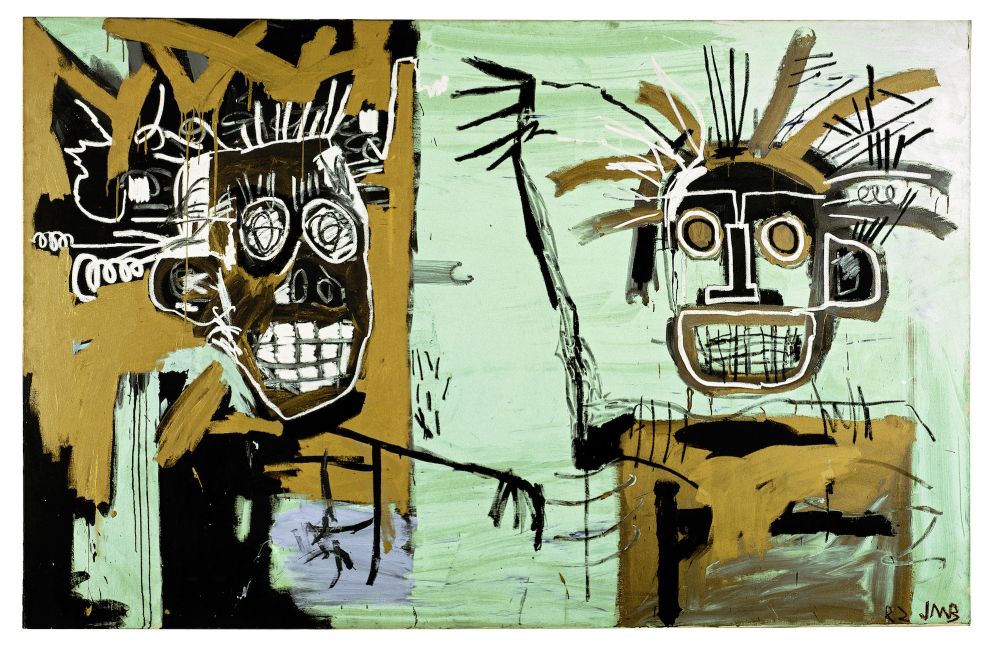
Some risibly bad art by Jean-Michel Basquiat
Feminists and other leftists don’t like it, of course, which is why they have created cults not just for Artemisia Gentileschi, but also for the risibly bad Black artist Jean-Michel Basquiat and the parodically minimalist Jewish artist Mark Rothko (see Brenton Sanderson’s three-part study of Rothko). Unlike them, Gentileschi valued realism, even if she didn’t achieve it. Basquiat and Rothko are part of what Tom Wolfe calls The Painted Word, that is, art that depends for its success not on its own merits, but on the spinning of verbal webs by disproportionately Jewish critics, academics and dealers. But Caravaggio’s realism — his ability to capture reality in paint — was not an isolated act of genius. It is no coincidence that his great art belongs to the same period as the birth of modern science and anatomy. Other White men were looking at the world and trying to understand and represent it in objective ways. Caravaggio was obsessed with light; Gentileschi was obsessed with herself.
The might of the “male gaze”
So are many of the feminists who now celebrate her and her subversive gynocentric reclamation of “breasts and bottoms as conceived by the male gaze,” as the Guardian journalist Rhiannon Lucy Cosslett put it. But if Cosslett wants true subversion, she should consider the fact that female breasts and bottoms were actually created by the male gaze. You could almost say that the human female is a work of art created by the human male, because countless acts of sexual selection down the course of evolution have favoured some types of women and disfavoured others. The sexual selection has worked in the other direction too, shaping male bodies according to female preferences.
But humans are not like Birds of Paradise, with drab, selective females and spectacular, attention-seeking males. The shaping of women by the “male gaze” may have been particularly strong in Europe when women were competing for the attention of skilled hunters in the colder and harsher European environment. The anthropologist Peter Frost argues that this female competition explains the variety of eye- and hair-colours found in Europe, where genes for blue eyes and blond hair appeared under pressure of the male gaze. In prehistoric times, White women were evolving special beauty even as White men were evolving special creativity.
Opposing beauty, pursuing power
In modern times, that White female beauty was celebrated by the art of White male creators. Later still, both the art and the beauty were attacked by leftist ideologies invented or decisively influenced by an alien group called Jews. I agree with a fascinating article at National Vanguard arguing that “Jews themselves are an unattractive and, on average, ugly people” and that “Jews, as a group, oppose beauty.” Indeed, the Talmud advises Jews not to regard physical beauty as important in marriage: “For ‘false is grace and beauty is vain.’ Pay regard to good breeding, for the object of marriage is to have children” (Taanith 26b and 31a).
The cult of Artemisia Gentileschi is a product of those leftist ideologies, celebrating a painter who was mediocre at her rarely achieved best. And just as Gentileschi’s art was not beautiful, nor was Gentileschi herself. She looks masculine and muscular, with high testosterone that may have given her the ambition and drive to promote herself in a way that her art could not do on its own merits. And she had novelty value as a female painter, of course. Cosslett says that a “large part of why Gentileschi captivates is because she triumphed against patriarchy.” But feminists like Cosslett don’t genuinely care about patriarchy or about rape. It wasn’t the Guardian or BBC that exposed the Muslim rape-gangs of Rotherham and numerous other British towns and cities. But it is the Guardian and BBC that support the continued growth in Western nations of Islam, which competes with Orthodox Judaism for the title of the world’s most patriarchal and misogynistic religion.
Instead, feminists like Cosslett care about themselves and about warring on truth, beauty and goodness. The cult of Artemisia Gentileschi is a small but characteristic battle-front in that war. Gentileschi was a bad artist who created ugly art. There are thousands of male artists far worthier of exhibitions at the National Gallery and of praise in the mainstream media. But those male artists don’t receive the attention they deserve. Not while leftism rules the media and inverts reality in its perpetual quest not for truth and beauty, but for power and revenge.





Aside from its propagation of the absurd myth of evolution, this essay is very good. I salute you.
Aside from the absurdity of denouncing a theory you can’t refute I agree with you. This essay is very good.
Darwin was simply another gentile useful idiot.
I am curious if the featuring of an artist with decapitation scenes in their collection is intended by the National Gallery to attempt to bring in the Moslem crowd?
“Other White men were looking at the world and trying to understand and represent it in objective ways. Caravaggio was obsessed with light; Gentileschi was obsessed with herself.”
This reminded me of Schopenhauer’s comments about women and painting (1851):
“Nothing different can be expected of women if it is borne in mind that the most eminent of the whole sex have never accomplished anything in the fine arts that is really great, genuine, and original, or given to the world any kind of work of permanent value. This is most striking in regard to painting, the technique of which is as much within their reach as within ours; this is why they pursue it so industriously. Still, they have not a single great painting to show, for the simple reason that they lack that objectivity of mind which is precisely what is so directly necessary in painting. They always stick to what is subjective.”
http://www.theabsolute.net/misogyny/onwomen.html
How dare Art overlook the towering edifice of Ayn Rand [Alice Rosenbaum]?
Her immortal philosophy was even named Objectivism. . .
She had a girlfriend named Nathaniel Branden [Natan Blumenthal]. See how R A N D is part of Branden’s name? He claimed he picked the name from a phone book- the cheeky effrontery, the chutzpah. On good authority, from New York insiders- Branden means Ben-Rand, or Son of Rand. To replace the Son of God, I presume.
Branden had a book service as part of NBI- Nathaniel Branden Institute. He was pushing books from the likes of Betty Friedan and Mortimer Adler. Adler was commie/nwo from Aspen [in later years]. Friedan [Friedman] authored The Feminine Mystique. She was a card-carrying member of the Communist Party.
After the famous split of 1968 [Rand/Branden] we would go up to Branden’s house to record Seminar records [Q&A]. In conversation after one session, Branden ejaculated- “The Only difference between men and women is that men can’t have babies.” One sees here a total break from Objective Reality. . .
Fry was obviously lampooning solipsism in the snippet you quote. A solipsist would not poke fun at solipsism, because there would be no one else to let in on the joke. I do appreciate this site; about half the articles are provocative and well written. But for those of us who think: “well, the Jews are very accomplished & clever & funny but that they do not always act in ways that are good for the goyim, and maybe we should be able to point that out very politely” — more or less my position — it is depressing to think that you can’t even like Stephen Fry who is hilarious; protective of free speech; and has lost quite a bit of weight in recent years. Half-Jewish? Why don’t you cite the Nuremberg laws? You’re broadly correct on the arty points. Thank you.
“Why dont you cite the Nuremberg Laws?”
For someone who by all evidence is not a full borne ignoramus, that closing sentence is quite trite. I had someone, in addition to such greatest hits as “racist” and words that end in “phobe” say almost exactly the same thing to me as a reply to a totally innocuous and observational comment recently. It was heavy handed and desperate then, even more so now.
I also went on to explain the utterly misunderstood notion of said Laws and the large part the Jewish leaders themselves played in writing them, as mixing with the Goyim was not in their best any interests any more than the reverse for the German Christians.
In defense of Gentileschi, her media of choice was not her own menstrual blood, like today’s feminist painters. But if she were alive today…all bets would be off. Aw, hell, let’s be honest: she’d be using the blood. And I’ll give you two guesses whose head would be getting severed in her big set piece.
Isn’t it possible that she was in fact an excellent realist painter and Mr Langdon’s erroneous judgment of her self-portraits (which just about all her paintings are) is due to the fact he does not know that Gentileschi had one arm longer and fatter than the other, and a stiff trifold goiter that prevented her from turning her head at a normal angle? I am not saying I know these things to be true, only that they are possible. And maybe the wrong shadows were a DeChirico trick avant la lettre? As for the composition, I don’t know…. and colors…. no, I can’t think of anything on that score either. Well, forget the whole thing. She is just dreadful.
“Most patriarchal and misogynistic” as if they’re bad things? If we had both, we’d be on the path to salvation regarding divorce rates, abortions, our women whoring themselves as teenagers at the clubs every weekend, their seeking BBC, etc.
As for “Muslim rape-gangs”, they’re “Pakistani rape-gangs”. Calling them Muslim is like calling Mexican drug cartels “Catholic drug cartels” or meth users “Protestant meth users”. It’s disingenuous as well as crudely and stupidly propagandistic and mendacious.
We should be above this.
Insightful essay nonetheless.
The rape gangs are not looked down on by the rest of their community as their religion endorses their behaviour. This is why the religion is significant in these cases and why it is relevant to these rapes. They are copying the example of their prophet, who is perfect, therefore they are doing nothing wrong. So their religious community does not condemn them.
Contrast this with the host community, which treats its own rapists as outcasts and condemns them and in comments under articles the ppl say ‘hang them’
There’s no evidence their religion is pushing them to rape and drug white girls. This is the “movement’s” bias. These pakis are the lowest of the low. I’ve spoken to religious pakis and they’re appalled by what they’ve read and heard and they think their fellow countrymen should be killed if found guilty. I’ve traveled throughout Pakistan and the Middle East.
What you’re saying is like what I’ve heard some Muslims say: “All whites support Israel and want to bomb our countries because of their Christian beliefs.”
I even recall hearing the “movement” state that Muslims weren’t ostracizing ISIS and other extremist elements: BS.
Reading the “movement’s” sites made one think all Muslims supported ISIS. This is akin to saying all Christians handle snakes.
I don’t buy zionews telling me the paki rape gangs are “islamofascists”.
As an atheist of Danish heritage, I don’t want Muslims in America or in the Old Country, because the overwhelming majority aren’t white.
I have seen no condemnation of the muslim rape gangs operating in this country by their religious leaders. This is because these rapists can quote the Koran to back up what they do. White rapists never quote the Bible to justify what they do. I stand by my point that the mslm rape gangs are following the example of their prophet, who was perfect.
Look harder.
I’ve spoken to enough Muslims and Muslim leaders to know that anyone involved in such heinous crimes besmirches Islam and this is not to be tolerated.
Paki rapists can quote the Koran as much as they want. What’s amazing is that you actually believe them. This is like the Mexican cartel hitmen wearing crucifixes as they shoot down the contending gang. See, they’re Catholics!
White rapists don’t invoke the Bible since religion is dead in the West and they can’t use it as an excuse.
You can stand by your point as much as you want. You’re clearly an Islamic scholar.
Why are you wasting your time publishing such nonsense? The critique of some artist from centuries ago? Pathetic.
Why indeed? Amazing how old this practice is. Didn’t that Ruskin fellow do the same with long-dead painters he admired, (like Titian and Veronese) who, even worse, were dead white men? This should cease.
I assume you lay the blame at in part on Cosslett who exhumed Gentileschi to repackage her as a proto-feminist and even as a painter, instead of focusing on her own admirable work on pressing current issues in her magazine The Vagenda (the name alone is a winner).
How about promoting instead the work of an Israeli woman painter (Siona something) whose paintings embody truly universal themes like Kapparot (swinging chickens over your head and smashing them against the wall to purify yourself for Yom Kippur)?
Seriously.
Presumably you also feel that the redundant, pointless and absurd exhibition of the work of this laughably bad artist at London’s National Gallery – and the reams of self-congratulatory liberal garbage published in leftist rags like the Guardian dishonestly making her out to be some kind of early-day “feminist” and artistic “genius” – are equally “pathetic” ? Or do you believe that it’s perfectly ok for the leftist idiots to publish and promote this kind of self-worshipping feminist claptrap, and nothing at all should be said in a forum such as this one to contradict it ?
Truly one of the most enjoyable articles I have read in quite awhile. Informative and historical while also contrasted to contemporary sentiments. I have been subjected to more than a few exhibits in the UK filled with squiggly lines with grand names, all of which had hundreds of gawking cosmopolitans breathlessly discussing how profound everything was.
Maybe I’ll be goring an ox or two here, I don’t know. But for my part, I don’t care how “great” a European artist is when they are painting stories/fables from the Old Testament where gentiles are being condemned or slaughtered by their betters. I wouldn’t hang that Caravaggio (or Gentileschi version) or anything similar in my house (or barn) if you gave it to me for nothing. If I didn’t need the money, I might use it for kindling Can’t you see what it represents. Even back then, painters didn’t see what they were doing. Why did people love this evil stuff even back then.
Now, annunciation, Nativity, healings, ascension, etc. might be more my style even if not of the quality of Rubens, Rembrandt, etc. That those events may be fables or metaphors as well is okay with me.
https://www.jesus-story.net/wp-content/uploads/2019/02/The-Birth-of-Christ-Federico-Barocci-1597.jpg
Couldn’t this painting depict any happy mother and father; doesn’t have to be the Christ child. Or maybe it must. This is a great work.
I am put in mind of Tom Wolfe’s “The Painted Word” about so-called “modern” art and an analogous little book about architecture, “From Bauhaus to My House”. It is the bullying of credulous people to embrace ugliness, for sale at high prices.
[mod: tom wolfe’s t.p.w. is mentioned in the article. search for “basquiat.”]
My thanks to the Moderator, standing corrected as to failing to notice that author Langdon cited Tom Wolfe’s book about “modern” art, late night dyslexia. But on review, the matter reduces to: ugly people hate beautiful people, and derivatively, beauty.
Why? Because Langdon (my favorite writer on this site!) is attempting to wake people up from their stupid slumber to the 3,000+ years of on going destruction from the Tribe of Evilness. The article illustrates that even from a “harmless” painter centuries ago their sick propaganda was being splattered on indigenous Europeans.
The critique and showcasing of Gentileschi’s work is another example of the millions upon millions of assaults on beauty, decency and the genius of the European race across the globe. The expressions of Artemisia in her work show arrogance and subtle glee with the severing of a White man’s head. Not even a drop of horror is admitted from her chubby face while participating in such violence.
What an interesting article, thanks. I’m no connoisseur of the arts but even I can see that these painting are clumsy and amateurish. It’s refreshing to hear the Guardian’s drivel challenged by someone who seems to know what they’re talking about and isn’t afraid to speak the truth. And a comments section that isn’t censored, what a novelty ! Keep up the good work.
We are looking for an explanation why Feminism, which is about ‘White males’ beheading and castration, is a product of white females. Mary Woolstonecraft, Catharine Macauley, Judith Sargent Murray, Margaret Fuller (and counting) were all Anglo-Saxon. The ‘Women’s Social and Political Union’ (WSPU), the suffragettes, was a British phenomenon. The ‘Women’s State Temperance Society’, was a WASP phenomenon clamoring that “the only hope” for Prohibition was “putting the ballot into the hands of women.”
“Leftists hate beauty, truth and goodness, and delight in the destruction of those things. ”
We have to ask in terms of natural selection how this negative characteristic of the Left came about. This does not require ‘evolution’ as such, as evolution in the full sense requires new types of genes to emerge, and this is not necessary for the purpose of examining human variety, as wide variation of humans is possible from the current and existing gene pool and natural selection alone can produce all the required variation to explain all variations in humans that we have, and over only a few thousand years as no new genes are required.
The same principle applies to dog breeding – after a natural disaster such as an earthquake, all the breeds quickly revert to a wolf-like dog, and from a few packs of these mongrels it would be possible to re-breed all the dalmations and alsations all over again.
This is relevant to the part of the article about blue eyes and blond hair and feminine beauty. A race can change pretty quickly in terms of female appearance in cases where the top males had several wives each and their children had more resources and better survival rates due to the status of the male. Especially if the tribe was taking women from defeated tribes where the defeated tribe was not too dissimilar to their own. Suppose, for example, that the top males had 30 children each and they were all the children of captured mothers who were all the most blue-eyed and blond haired. This would soon make a huge impact over a few generations, especially if a small group of the top males and their families subsequently formed the genetic stock of a new colony in new lands after emigrating.
Maybe this is why some Syrians are so white and beautiful – thousands of white women were captured by arab slavers and they would pick the most beautiful for the wealthiest arabs.
When humans started to go for monogamy this process of changing would slow down, and now the only selection taking place in white races is (1) the state is paying the underclass to breed (2) everyone else has children if they want them, apart from loyal and moral humans who happen to have found a partner who does not wish to have children, so neither of them have children. The man or woman who has genes that make them want to be childless, and their partner childless, such genetic types have always been amongst us, but in the past the gene simply never got a chance to express itself as there was no option to remain childless before recent times, before contraception and before women’s rights told women that motherhood was not a worthwhile role when they could instead be ‘having a career’. Now this gene for wanting childlessness is rapidly removing itself from the gene pool (3) Middle class and educated having children later due to the women ‘pursuing her education and career’, thereby reducing the breeding rate of the more intelligent who are told that child rearing is a waste of their talents when they could be doing some professional man’s job instead.
It is also worth noting that the concept of beauty is only what a few groups of neurons think it is, so when a woman’s appearance causes these to fire off in the observing male, the male in whose brain they reside, this male considers the woman to be beautiful. The exotic birds do the same and pick males with long colourful tail feathers. In this instance our idea of beauty and that of the birds coincides, so we say what beautiful birds they are. If we replaced these neurons with a set that admires women who have long faces and noses, then by now women would look more like dogs and we would paint the ones that were most dog-like. This is why cartoons ignore noses (sometimes completely) and focus on the eyes. The neurons have no interest in the noses. If the neurons that detect human beauty centred on the nose instead, cartoons would all be about noses and the eyes minimised or ignored. Also, some neurons are fired off by large breasts and other sets by small ones, but that is another story.
But as for how it came about that 10-15% of whites would be leftists who hate beauty, truth and goodness, and who hate whites with these characteristics, and so now hate their own race, and work with ((another hostile race)) against their own race? – how could this self-harm genetic type emerge or at least be sustained if natural selection was applying? Why would these types not be naturally selected against?
The explanation lies in the way different types are preserved in the human population by equilibrium, unlike with dogs where all the dogs in a pack end up the same as each other. In the land of the honest, the thief can do very well. In the land of the co-operative where almost everyone is friendly, the small minority of the dishonest and the takers, the rapist and criminal, such lower types have an increased advantage, especially if the defences of the better types weaken, and they prefer not to fight. But as the lower types, the criminals, or those with lefty genes, as they increase, their advantage decreases as there are fewer to parasite on and the defence instincts of the better types improve and they learn how to switch from ‘nice mode’ to ‘nasty mode’. So an equilibrium is reached.
Sometimes the lefty types would be clever and sociable, but what would always distinguish them both then and also today, would be that they had a ‘dislike’ of those they preyed on. This is essential of you are a taker and that is your way of getting resources. You must think you have a right to take and you must see the better ones as the enemy who deserve to have their things taken, otherwise how could you strip others of their assets and still sleep soundly and peacefully. This is why the left not only want to take stuff off better types, they also ‘hate them’ and today the hatred of the left manifests itself as a hatred of white people generally, just for being better, for being superior.
So the morals of the left are completely different, they see good people/better people/superior people as ‘the enemy’ and this alternative set of morals replaces normal moral thinking. They lack a normal conscience or concept of right and wrong. We must not assume they think as we do. When they destroyed S Africa they saw it as a good thing as they destroyed the rule of the superior, and the fact that the blacks also suffered once white rule ended (for the blacks – no jobs, tribal warfare, electricity blackouts, crime) – the black suffering under black rule, this would not make the white left hesitate to do the same again to any other white-run country and still see it all as a ‘good thing’ in their perverted alternative moral code.
“They want women to be unhappy, angry and militant.”
In other words, Jewish.
No question in my mind that this author nails the purpose behind the sudden discovery and elevation of this artist.
But it’s unnecessary to disparage her talent in such extreme terms, and from what he says here I get the impression that Mr Langdon’s only measure of artistic merit is strict verisimilitude.
He must love the contemporary photo-realists. Though photography changed the equation nearly 200 years ago.
I agree with what you say. According to Mr. Langdon, if I understand him correctly, a painting or drawing is worthwhile only if it has a photographic quality of reallism. Or at least that is the way it sounds to me. Yet even photographs do distort reality without any intent on the part of the photographer. That’s the camera’s nature.
I don’t have any attraction to Gentileschi’s beheading illustration, or her self-centered works, but not because of lighting, composition or proportion imperfections.
Remember “This is not a pipe” by Magritte?
I was interested to come across your blog about Gentileschi and Vigee-Le Brun. Both are wonderful artists and deserve further recognition.
I found it perplexing, however, as to why you omitted absolutely essential facts about Gentileschi, especially as they entirely undermine your negative and irrefutably incorrect characterization of the work.
You contend that Gentileschi would not be recognized if not for her gender. This is absolutely, verifiably false. Gentileschi was admitted to the Florentine Accademia Delle Arti del Disegno (Academy of the Arts of Drawing) by her contemporaries. She was actually the first woman ever admitted. In addition, Gentileschi received numerous commissions, including from Cosimo de Medici and King Fellipe IV of Spain. Lastly, in her own lifetime, Jerome David described her as “A miracle in painting, more easily envied than imitated.”
These facts prove irrefutably that Gentileschi was respected by her 17th century Florentine and artistic peers. It also completely exposes your critique of her oeuvre as uninformed, ideologically-driven, and incorrect.
Your anachronistic politicalization of both Gentileschi and Vigee-Le Brun does a disservice to both of their works. As conservative critic River Kimball stated “by subordinating art to a non-artistic agenda one drains art of its intrinsic dignity and pleasure.”
Not only have you engaged in a false simplistic ideological characterization, but in aiming to belittle Gentileschi, you have actually only revealed your own limitations in cultural appreciation and academic credibility.
“Vigée-Le Brun represents herself as attractive and enjoying both life and being a woman. Feminists don’t want women to be attractive and happy like that. They want women to be unhappy, angry and militant. That’s one big reason they prefer the untalented Gentileschi to the highly talented Vigée-Le Brun.”
“Cosslett says that a ‘large part of why Gentileschi captivates is because she triumphed against patriarchy.’ But feminists like Cosslett don’t genuinely care about patriarchy or about rape.”
“Instead, feminists like Cosslett care about themselves and about warring on truth, beauty and goodness.”
Japan is a simple and on-going demonstration of this. For whatever reason, artistic ability there is much more evenly distributed between men and women than in the West, and there’s a long list of women who’ve (legitimately) found success as artists. They are not white, and, as feminists keep telling us, they are suffering under patriarchal oppression in a backwards country, and so you would expect them to be of interest to feminists. But feminists are not telling any stories about them triumphing against the patriarchy, or gloating that they’re much better than stupid white men. Feminists ignore them.
Very odd. Could we shed some light on this by examining their artistic differences?
https://www.youtube.com/watch?v=PZSOGZFfSDk
https://www.youtube.com/watch?v=OGWO3u8zgTU
Yes, I think I found the problem.
I think this is very unfair. Imho Gentileschi’s “Decapitation” is a powerful, terrifying, well made painting. If you look up her other paintings, you can see most are not ugly at all, but certainly not much more than average fare of the time (even the mediocre stuff of this era is so much superior than most of contemporary art). Other, greater artists were far more obsessed by self portrayal, Rembrandt or Dürer come to mind. It is certainly true that some feminists try to make Gentileschi into some kind of Renaissance Frida Kahlo, wildly overrating her work.
I’ve enjoyed reading this article and the comments, although I think the author is being a bit rough on Artemesia. Her work is good, if average, and I don’t think her mediocre, but I agree that all the praise of her being a repressed genius and long-lost master is overdone. Many, many artists become forgotten. And I think her work is far better than most modern art; Picasso, for example, is a fraud.
And now, history is being scoured for any woman artist who was presumably repressed.
We can argue most women artists are not up to male standards, although I think Vigee Le Brun is superb; and can you really consider Jane Austen inferior to male writers? Although I admit I prefer Byron.
I was also glad to see Seraphim note Margaret Fuller. I have always admired her life and stand, and wrote a play about her that was performed as part of a local university’s Women’s History Month. It was well-liked, but no one wants to put it on, ditto with a screenplay I wrote about her. It seems Margaret has some kind of poison to her…like Kate Hepburn was once ‘box-office poison.’ I think Margaret is infinitely more interesting that Emily Dickinson, who to me wavers between brilliant, Yankee haiku and Victorian Hallmark card-like pensees. Really, women love Margaret, adore the play, but directors read it and…nothing.
But also I’m a white male, Margaret was white, so…
As for Artemesia’s subject of beheading, they were depicting the heroine Judith, from the Apocrypha, and was a very popular heroine in the Renaissance. They couldn’t get enough of her, and almost every artist had a crack at Judith offing Holofernes. Vivaldi wrote an oratorio, Judith Triumphans, where besieged Israel is compared to besieged Venice, and the music is pretty good. So, Artemesia probably was responding to consumer demand as much as any supposed male hatred.
As for Japan, we have to remember that its most famous novel, The Tale of Genji, was written in the 11th century, by Lady Murasaki.